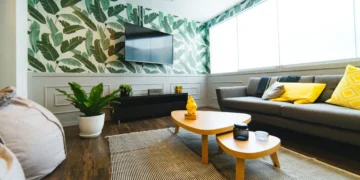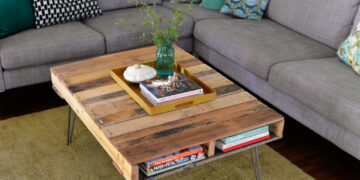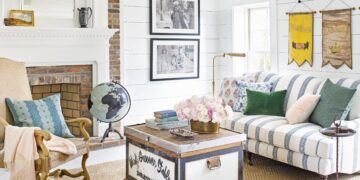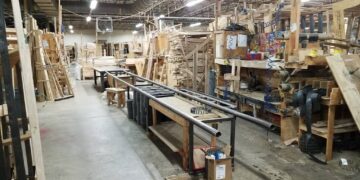Over the past few decades, the furniture industry has seen an exponential growth in designer collaborations and partnerships. In this article, this trend has revolutionised the industry, bringing together creative minds from various fields to create unique and innovative furniture designs. These collaborations and partnerships have become increasingly popular as consumers demand more personalised and distinctive products that reflect their individuality.

Designer collaborations and partnerships in furniture
The rise of designer collaborations and partnerships in furniture can be attributed to several factors. One of the main drivers is the desire for innovation and uniqueness. Consumers today are looking for furniture that stands out from the rest, and collaborations between designers and furniture manufacturers have made it possible to create furniture that is both functional and aesthetically appealing.
Another factor that has contributed to the growth of designer collaborations and partnerships is the changing nature of consumer behaviour. With the advent of social media and e-commerce, consumers are now more informed and have higher expectations when it comes to the products they purchase.
They want furniture that is not only functional but also reflects their personal style and taste. Collaborations between designers and furniture manufacturers have made it possible to create products that cater to these evolving consumer needs.
Collaborations and partnerships in furniture design also allow designers to experiment with new materials, technologies, and manufacturing techniques. By working with furniture manufacturers, designers can access the latest technology and production methods, which can lead to the creation of innovative and sustainable furniture designs.
One of the most notable examples of a successful designer collaboration in furniture is the partnership between Italian furniture manufacturer Cassena and the designer Philippe Stack. The two have collaborated on several projects, including the iconic Louis Ghost Chair, which is a modern take on the traditional Louis XV armchair.
The chair is made from a single piece of polycarbonate, which is both durable and lightweight, and is available in a range of colours. The Louis Ghost Chair has become a design classic and is featured in the collections of several museums, including the Museum of Modern Art in New York.
Another successful collaboration in furniture design is the partnership between American furniture manufacturer Herman Miller and designer Charles and Ray Eames. The two worked together on several projects, including the iconic Eames Lounge Chair and Ottoman, which is now considered a design classic. The chair is made from moulded plywood and leather, and its unique design has made it a favourite of architects and designers around the world.

More recently, we have seen collaborations between furniture manufacturers and fashion designers, such as the partnership between Italian furniture manufacturer Kartell and the fashion house Moschino. The two collaborated on a range of furniture designs that feature the iconic Moschino heart logo and are made from transparent polycarbonate. The collection has been a hit with consumers who appreciate the playful and innovative designs.
In addition to collaborations and partnerships between designers and furniture manufacturers, we have also seen collaborations between designers and retailers. One of the most successful examples of this is the partnership between Swedish retailer IKEA and designer Tom Dixon. The two collaborated on the DELAKTIG sofa, which is a modular sofa system that can be customised to suit different needs and preferences. The sofa has been a huge success and has won several design awards.
The growth of designer collaborations and partnerships in furniture has not only led to the creation of innovative and unique products but has also helped to raise the profile of furniture design as an art form. Collaborations between designers and furniture manufacturers have brought together different disciplines, including art, architecture, and industrial design, and have resulted in the creation of furniture that is both functional and aesthetically appealing.
As the demand for unique and personalised furniture continues to grow, we can expect to see more designer collaborations and partnerships in the furniture industry. These collaborations will not only help to create new and innovative products but will also help to elevate the profile of furniture design as an art form.
However, it is important to note that collaborations and partnerships in furniture design are not without challenges. One of the main challenges is ensuring that the collaboration between the designer and the manufacturer is a good fit. The two parties must have a shared vision and approach to design, and they must be willing to work together to create a product that meets both their needs and the needs of the consumer.
Another challenge is ensuring that the collaborative process is efficient and effective. This requires open communication and a willingness to compromise on both sides. Designers and manufacturers must work together to ensure that the design process is smooth and that the final product meets the necessary quality standards.
Despite these challenges, collaborations and partnerships in furniture design have proven to be successful and are likely to continue to grow in the future. These collaborations allow designers to explore new materials, technologies, and manufacturing techniques, and they provide manufacturers with access to fresh ideas and perspectives.
They also allow consumers to purchase unique and personalised products that reflect their individual style and taste. In conclusion, the growth of designer collaborations and partnerships in furniture has transformed the industry, bringing together creative minds from various fields to create unique and innovative furniture designs.
These collaborations have been driven by a desire for innovation and uniqueness, changing consumer behaviour, and a need to experiment with new materials and manufacturing techniques. As the demand for unique and personalised furniture continues to grow, we can expect to see more designer collaborations and partnerships in the furniture industry, leading to the creation of new and exciting products that push the boundaries of furniture design.
In addition to the benefits of innovation and creativity, designer collaborations and partnerships have also had a positive impact on sustainability in the furniture industry. Many collaborations have been focused on creating sustainable and eco-friendly furniture designs. For example, Danish furniture manufacturer Fritz Hansen and designer Jaime Hyon collaborated on a series of chairs made from recycled plastic, while Dutch designer Piet Hein Eek worked with IKEA to create a collection of furniture made from recycled materials.
These collaborations help to reduce the environmental impact of furniture production and encourage sustainable practices in the industry. As consumers become more environmentally conscious, sustainability is likely to become an increasingly important factor in furniture design, and collaborations between designers and manufacturers will play a crucial role in driving this change.
Another benefit of designer collaborations and partnerships in furniture is that they provide a platform for emerging designers to showcase their work and gain exposure in the industry. Many collaborations have featured up-and-coming designers, giving them the opportunity to work with established manufacturers and gain valuable experience.
Overall, designer collaborations and partnerships have had a significant impact on the furniture industry, bringing together different disciplines and perspectives to create unique and innovative furniture designs. These collaborations have been driven by a desire for innovation and uniqueness, changing consumer behaviour, and a need to experiment with new materials and manufacturing techniques.
As the demand for personalised and sustainable furniture continues to grow, collaborations between designers and manufacturers will continue to be an important driver of innovation and creativity in the industry. These collaborations will provide a platform for emerging designers, promote sustainable practices, and help to elevate furniture design as an art form.












